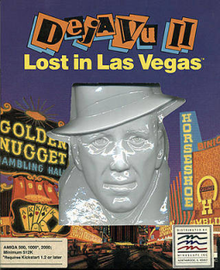Deja Vu II: Lost in Las Vegas
| Deja Vu II: Lost in Las Vegas | |
|---|---|

Cover art used for Amiga, Apple II, Atari ST and DOS versions
|
|
| Developer(s) | ICOM Simulations, Inc. |
| Publisher(s) | Mindscape |
| Composer(s) | Hiroyuki Masuno (GBC version) |
| Engine | MacVenture |
| Platform(s) | Apple IIGS, Macintosh; Atari ST, CD-i, Commodore Amiga, Game Boy Color, PC, Pocket PC |
| Release | 1988 (Mac) 1989 (Amiga, Apple IIGS, Atari ST) 1990 (DOS) 1999 (GBC) |
| Genre(s) | Adventure |
| Mode(s) | Single-player |
Deja Vu II: Lost in Las Vegas is a point-and-click adventure game, the sequel to Deja Vu: a Nightmare Comes True, set in the world of 1940s hard-boiled detective novels and movies. It was the last game made in the MacVenture series.
In this follow-up set in the late 1940s our hard-boiled hero Theodore 'Ace' Harding once again regains consciousness, this time in a bathroom at the Las Vegas Lucky Dice Hotel and Casino, with his memory intact. It soon becomes apparent that the Vegas mobster Tony Malone is missing a hundred grand ($112,000 to be exact) after the events that took place in Deja Vu (I): a Nightmare Comes True and that Ace has become the scapegoat; he is to return that money within a week or face the classic "or else"; in other words, his death.
Deja Vu II takes place in a sparsely populated Las Vegas reminiscent of the movie Bugsy, with just a few locations to explore. However, the player has the option to take the train to other cities including Chicago (if the player attempts to go to Los Angeles, St. Louis, or New York prematurely, Ace is killed by one of the antagonists, Stogie Martin), where locations from Deja Vu I are revisited. Connections to this background story are well explained, and the game is completely playable by itself. In fact, there are situations where experience with Deja Vu I can be a disadvantage by creating certain expectations, for instance: the phone in the office at Joe's Bar is not openable in Deja Vu I, in Deja Vu II it contains an important item. To get to the office the player has to climb the fire ladder from the street, which is "too high" to reach in Deja Vu I.
There is also a police presence in Deja Vu II, though they are not after Ace directly as in the first game. Here, Ace can be arrested immediately following the player doing some unlawful act in a public location. Examples of offenses are disturbing the peace (by breaking glass or firing a gun) and indecent exposure (not wearing any clothes). An arrest causes the game to be lost as Stogie posts bail and executes Ace in the desert (or at a cemetery if the arrest was in Chicago).
Like the other MacVenture games there is a time limit, in this case the hitman Stogie, who periodically reminds Ace to "come up with the dough". Although no longer affected by drug-induced amnesia (as in Deja Vu I), the player still experiences memory flashbacks when encountering certain environments or photographs.
...
Wikipedia
